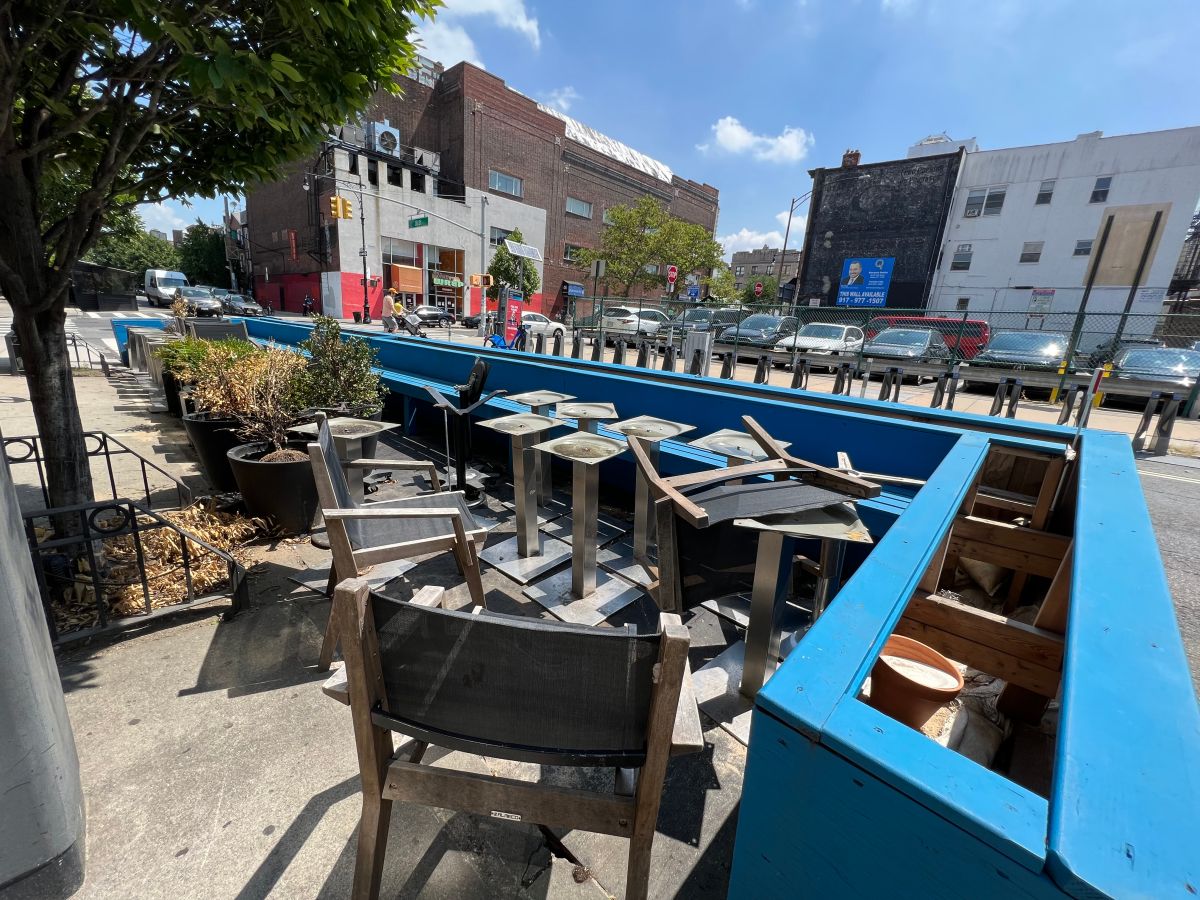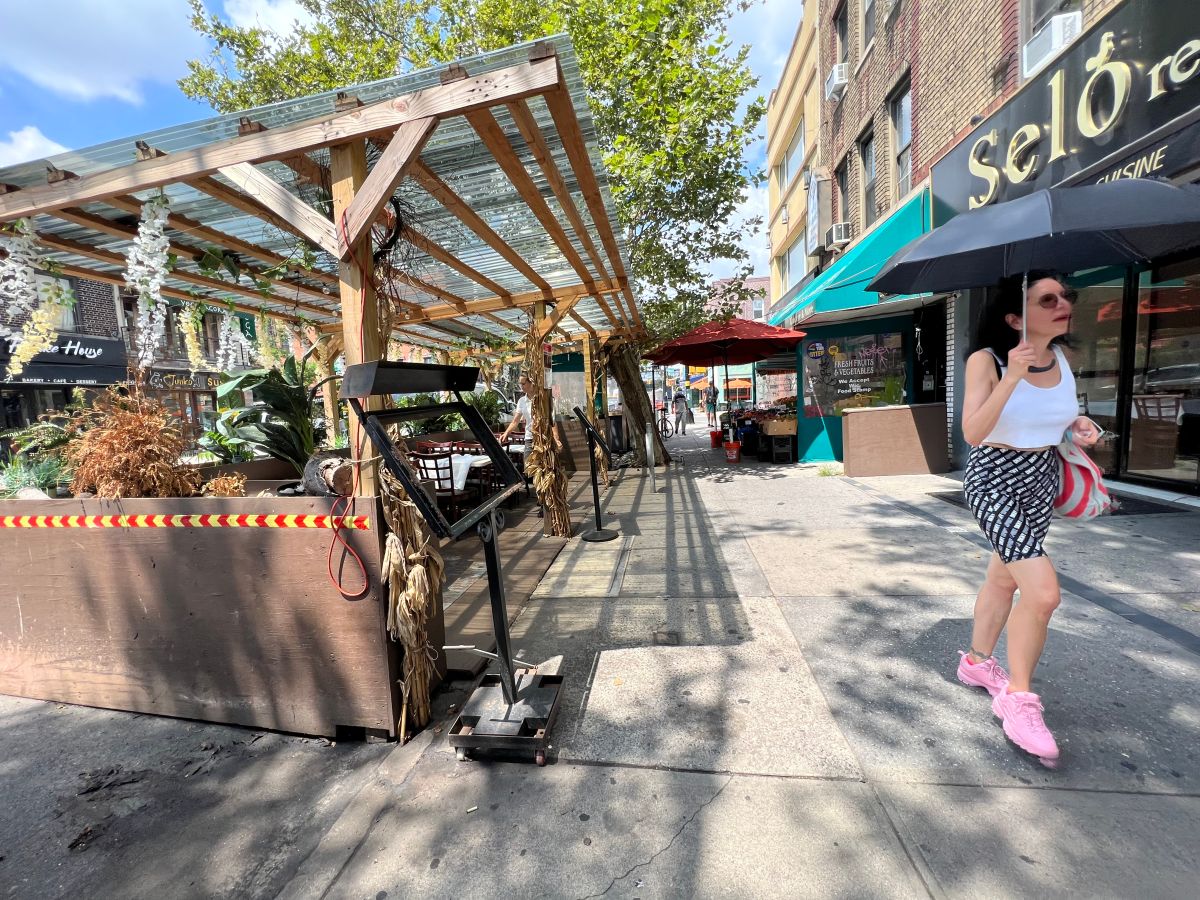In the hardest moments of the Covid-19 pandemicprogram creation “Open Restaurants”what has helped more than 12,000 restaurants of the Big Apple in the midst of the crisis, was a “lifesaver” for Latino merchants like Chano Morales, business owner Chano Cantina, in Astoria, Queens.
The Mexican, who came to be hanged due to the ravages that the pandemic caused after the order to close businesses, was able to stay afloat and even reach the other shore strengthened, thanks to the fact that the City allowed him to create a shed under the sidewalkwith outside tables.
“Leaving the program permanent would be a success, because using the spaces we have helps us to recover much of what we lost,” said the restaurateur, at a time when the so-called Week of restaurants begins, and when the clientele of restaurants tends to increase. messages.
But just as the City works on a plan to make the initiative “Open Restaurants” is permanent, the plan for tables in outdoor spaces received a new legal setback, which adds more thorns to the continuity of the initiative, which would give a low blow to the finances of small businesses, including many Hispanics and immigrants.
And it is that after last March a judge of the Supreme Court of New York asked the City put a magnifying glass on the program, after a lawsuit by 22 residents who complained about the enormous environmental impact of the initiative on the quality of life of New Yorkers, now the darts are back. A total of 35 plaintiffs from Manhattan, Brooklyn, Queens and the Bronx filed actions in court to end the initiative, complaining mostly of excessive noise, traffic, garbage and dirt, due to the “booth”-style structures that occupy streets in the big Apple.
“(The plan) results in increased and excessive noise, traffic congestion, uncontrolled litter and rodent populations, blockage of sidewalks and streets, making plaintiffs and others unable to safely navigate the streets and sidewalks of the city, and a decrease in parking that some depend on, ”says an aside from the lawsuit.
Robert Camachopresident of Brooklyn Community Board 4, one of the plaintiffs, criticized that in many cases, the original plan for which the program was created no longer even meets that objective.
“Now some restaurant owners are using the sheds for storage, not outdoor dining… some are full of trash; some have young people taking drugs, ”said the plaintiff.
Shannon Phippsof the community action group Berry Street Alliance, another of the plaintiffs, insisted that trying to preserve the program violates the law.
“We oppose government overreach and power,” the plaintiff said.
Joseph Joyowner of “Deli Restaurant” in Long Island City, he was concerned about the legal progress of the lawsuits against the plan that allows businesses to have tables outside and be able to recover the income they lost in the worst moment of the pandemic.
“If they take away our little tables outside, they take away a lot“, assured the Guatemalan. “It is not fair that we all pay for some. What the City has to do, and in that I understand the complaints, is to force the outside buildings that are not being used to be knocked down, but not to take away the outside tables from all of us, “added the small businessman .
Michael Sussmanthe plaintiffs’ attorney criticized that the “Open Restaurants” program, which was thought to be temporary, was implemented without taking into account the voices of the communities.
But regarding these complaints, the Department of Transportation (DOT), the agency in charge of managing the transition from the temporary plan to a permanent initiative, has defended the inclusion of the public in the process, holding various meetings and community boards.
Also, and repeatedly, as in his hearing in the City CouncilCity and DOT officials have made it clear that the idea is to keep outside tables, but not the “casita”-type constructions seen today, which are largely a bone of contention.
“A robust outreach and engagement program will be established at the community and municipal level to share design concepts prior to the City’s rulemaking process known as the City Administrative Procedure Act, or CAPA. It is through CAPA that the City will finalize and adopt formal rules related to the permanent Open Restaurants program, including rules for outdoor sidewalk dining structures,” the DOT warns of the plan moving forward between this summer and fall.
Despite the declarations of that organization, ordinary residents such as Lourdes Molina, 77 years old, who lives on 30 Astoria Avenue, says she hasn’t heard of any calls for meetings about the program in her neighborhood and said, visibly upset, on the corner of 38th Street that she wants the outdoor table structures removed soon.

“Look at that, that’s just dirt and grime. Plants and weeds have even grown around the structure, because that restaurant doesn’t even use those spaces anymore. That is where I think the City and the inspectors are failing. We have to put an end to that vagrancy and that the tables outside are only on the sidewalks that are wide and not in all of them, much less in the streets, ”said the Colombian.
Sebastian Hernandezwho works as a busboy at a restaurant on Broadway Avenue in Long Island City, called on the City to listen to residents’ complaints to come up with a balanced plan to address filth and clutter complaints, but asked that the program is not cancelled.
“This plan feeds many of us, because the tips grow and it gives more hours of work. Perhaps now many do not see it because it is summer but when the cold arrives those places are extra outside dining rooms that serve us. I hope they don’t remove them, “said the Peruvian.
In the midst of the lawsuit and complaints from residents such as the plaintiffs, and the call from businesses to continue with the program, which is proving to be quite a tough fight, Mayor Eric Adams once again showed its support for the initiative, which has made counties such as the Bronx, Queens and Staten Island, where previously having tables outside was unusual, now it is common and helps increase income for food businesses.
“This is an important industry,” said the mayor. “I’m a big fan of outdoor dining. And our restaurant owners have been through a very difficult period. Some of them are still behind on their payments. And whatever you can do to help our restaurant industry that employs dishwashers, waiters, busboys, this is an important industry and it’s a marker of our city,” the Mayor said.
Sin embargo Adams He accepted that some sites are not fulfilling the reasons for which they were created and said that it is urgent to do a review in this regard.
“The demand is going to develop by itself. But I am in favor of outdoor dining. I think we need to change things because some of the outdoor eating places have become dangerous. They have become places that are not suitable,” said the local president.
“And I think there is a way to modify to standardize what the structure should look like, and they have to be used. Cannot be used for storage. It cannot be used for all other things. But I am in favor of outdoor dining. And I think it was a lifeline for the restaurant industry,” Adams added.
The emergency program that was created in 2020, will end in 2022, and if the Court does not decide otherwise, the plan indicates that from 2023 it would be permanent, but all the restaurants that have currently benefited from outdoor spaces, They will need to reapply for their permits.
Data from the ‘Open Restaurant’ program in NYC:
- 12,000 restaurants, bars and cafes currently have outdoor and street seating.
- There were 1,000 outside food places in NYC before the pandemic.
- 5,900 outside eaters are in Manhattan.
- 3,000 outdoor restaurants are in Brooklyn.
- 2,400 are in Queens.
- 659 are in The Bronx.
- 187 are on Staten Island which before the pandemic had 0.
- An estimated 100,000 jobs were saved thanks to outside dining.
- 2022 ends the temporary emergency program.
- 2023 will be the year the program will start permanently.
- All restaurants will need to reapply for their licenses.
- 4 months will last the process to award sidewalk dining licenses.
- 5 months will last the process to deliver dining room licenses on the roads.
- $1,050 will be the cost of permanent licenses.
- $525 will be the value of the renewal.
–


